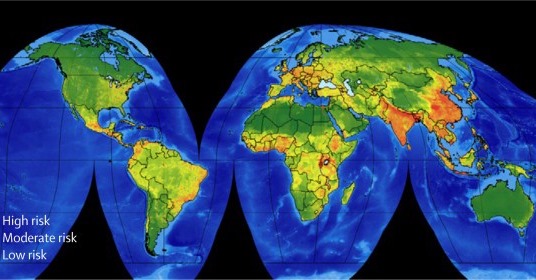He is seen as the first patient who got sick but some researchers believe the virus had already started raging earlier than that December 1st when he was admitted to a hospital in Wuhan, China with pneumonia. By December 10, there were 3 more patients and by the end of the month, there were 40 cases.
Soon the world would hear of a virus that was making people sick in Wuhan, China, and was going to spread even beyond China.

Initial work by Chinese virologists soon showed what the causative agent was – a coronavirus not found in humans. Now there are several strains of the coronavirus. Four types are found in humans and they usually cause the common cold. The ones found in other mammals are the ones that cause severe disease in humans. The two known ones are severe acute respiratory syndrome coronavirus (SARS-CoV) and the Middle East respiratory syndrome coronavirus (MERS-CoV). Whereas the coronavirus that caused SARS was isolated from a civet, the source of MERS is thought to be a camel.
The strain causing the people of Wuhan to get cases of pneumonia was named 2019-nCoV (novel coronavirus). Further work showed it shared 79.5% percent of the structure of another non-human coronavirus that had caused an epidemic in 2002-2003 – the SARS-CoV – and was 96% identical at the whole genome level to a bat coronavirus.
So a virus found in bats is causing disease in humans.
Now this phenomenon is not new. Pathogens from vertebrate animals that cause disease in humans are called “Zoonoses”. The process whereby the pathogen (bacteria, prions, protozoa, fungi, worms, viruses) springs over from the animal to the human is termed a “Spillover”.
Roughly 80% of viruses, 50% of bacteria, 40% of fungi, 70% of protozoa, and 95% of worms that infect human beings are zoonotic. Most of the identified reservoirs are mammalian in nature (roughly 80%). More than 60% of the roughly 400 emerging infectious diseases that have been identified since 1940 are zoonotic. Thus zoonoses are of particular public health interests.
We all know the famous ones like HIV-AIDS, Ebola, the flu, SARS, and even rabies. We get these diseases through direct contact with the body fluids of an infected animal, exposure to their habitats, through vectors like mosquitoes, and from eating contaminated meat.
Of all the pathogens, viruses seem to be the most lethal. They are simple creatures that mutate easily and are unaffected by antibiotics.
These diseases that reside in animals and have the ability to infect humans can be the cause of serious epidemics and even pandemics as seen with the Spanish Flu and HIV. They are also more difficult to eradicate than those pathogens whose final reservoir is the human, like smallpox and polio. One mammal that seems to get implicated in all this is the bat. It has been implicated in the spillovers of several zoonoses like Ebola, SARS, Nipah, and the ongoing 2019-nCoV outbreak. With an immune system that makes them able to harbor a lot of viruses without getting sick, they are the reservoirs of about 60 zoonotic viruses. It is estimated that each bat species harbors 1.79 zoonotic viruses. (The coronaviruses that caused both SARS and MERS are thought to have originated from bats, then infected the civet and camel respectively, and then humans).
Although it is impossible to predict when the next zoonoses spillover or what even allows certain pathogens to spill over, there are characteristics of these phenomena that allow epidemiologists to predict the areas on the planet which are hot spots for zoonotic spillovers.
In a 2012 paper by Morse et al in the Lancet, they teased out several hallmarks of zoonotic spillovers.
First, the frequency of emergence of new pathogens is on the increase. This increase seems to correlate strongly with increasing population density. Thus the expansion of human habitation, agriculture, travel routes, trade, and general changes in land use may be leading to humans getting exposed to more pathogens. We are encroaching on the habitats of these animals. This also means that areas with more biodiversity will see more of these zoonotic spillovers. So areas in the world with high population densities and biodiversity are more prone to see these events.
Based on these hallmarks of zoonotic spillovers, a few models have been created to depict how a new disease emerges. The 3-stage one by Morse et al really simplifies it. The first stage sees humans encroaching into the habitat of these wild animals through changes in land use or even caving (bats). Through contact, the pathogen spills over causing disease locally. This can range from small clusters of human cases to large outbreaks, some with the limited person-to-person transmission (eg, Ebola virus) and some without (eg, Hendra virus in Australia). The third stage is the large spread leading to a pandemic.
Also based on these same hallmarks, certain areas of the world are seen as hotspots. These are areas around the world’s rain forests – Latin America, West, and Central Africa, Southeast Asia, and the Pacific Islands. This is quite understandable due to the biodiversity of these forests and the fact that they are being encroached on actively for commercial purposes as well as due to population growth. Thus we first saw Zika come from Brazil and Ebola from Sudan and the Congo simultaneously in 1976.
Another important hotspot has spawned the present 2019-nCoV epidemic and also gave us SARS – Southern China.
The area has a huge population of bats. Moreover, it is also famous for the culinary culture of “Yewei” or “Wild Flavor” Cuisine. This involves “such exotic fare as camel hump, dried tiger penises, and bear bladders”.
Like Karl Taro Greenfeld writes in the book “The China Syndrome”, “Yewei” has become the perfect symbol of China’s newfound wealth; the Chinese would even call the period of the economic boom in the South “the Era of Wild Flavor.”
Some also attribute the attainment of sexual prowess and therapeutic effects from eating these exotic meats.
Thus in provinces like Guangdong, where SARS developed and, Hubei, where Wuhan is, there are thousands of wild animal markets or “wet markets” where one can buy all manner of animals including chickens, snakes, raccoons, dogs, civets, cats, monkeys, otters donkeys, sheep, pigs, foxes, badgers, bamboo rats, hedgehogs, and pangolins.
So inasmuch as these “wet markets’ have become symbols of China’s growing affluence, they may also be a vulnerability. They may be breeding grounds for zoonotic spillovers.
Between 2000 and 2003, Lee, Lau, and Chan, researchers from Hong Kong surveyed these markets in Guangdong and Shenzhen. This is an excerpt from their report:
“The animals are packed in tiny spaces and often in close contact with other wild and/or domesticated animals such as dogs and cats.”
Animals are stacked vertically so waste rains from one species to the other and since they are often slaughtered in the markets, blood joins in the fray.
The team further wrote, “The markets also provide a conducive environment for animal diseases to jump hosts and spread to humans”.
Interestingly, it was during this period that SARS broke out. This makes southern China a potent hotspot for zoonotic spillovers. The situation is further complicated by a political system that discourages sharing information and reporting such incidences.
Even as I write, the 2019-nCoV zoonotic spillover is looking more and more like it has the hallmarks of a pandemic. It has spread to 23 countries, sickened over 14,000 people, and killed 299 in China and one person in the Philippines.
It has been shown to be transmitted from human-to-human, even in cases where there are no symptoms, and even may survive on inanimate objects. A vaccine is at least a year away but with all the efforts being made worldwide, there is hope that the outbreak can be brought under control.
It will not be the last zoonotic spillover the world will see. Not as long as we keep encroaching on the habitats of wild animals and keep enjoying wild and exotic meats.
